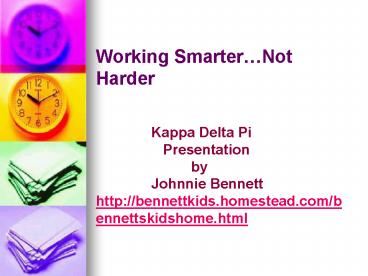Its all about time.. - PowerPoint PPT Presentation
1 / 21
Title:
Its all about time..
Description:
... nology.com/printables/ Create flashcards and studystacks, or ... http://www.scholastic.com/kids/homework/flashcards.htm. Have them swap the cards they have ... – PowerPoint PPT presentation
Number of Views:59
Avg rating:3.0/5.0
Title: Its all about time..
1
Working SmarterNot Harder
Kappa Delta Pi
Presentation by
Johnnie Bennett http//bennettkids.homestead.c
om/bennettskidshome.html
2
Its all about time..
- And how best to use it!!!
3
How are you spending your classroom time?
- How long are you taking to get things rolling?
- How many hours a week do you spend creating and
grading assessments? - How often must you redirect your students back to
task?
4
How can you make better use of that time?
- Quick start activities made easy using the
internet. - Archiving made simpleand fun!!
- Promoting the role of the active learner.
- Activities that accommodate all learning styles
5
Remember YOU DONT HAVE TO BE ORIGINAL, YOU
JUST HAVE TO PROVIDE THE BEST POSSIBLE LEARNING
EXPERIENCE FOR YOUR STUDENTS THAT YOU CAN!
6
You can keep them on task without being a
task master..
7
Getting them started.
- Manipulativesquick easy and can be saved for
reviews. - Have them do the cut-outs for homeworkand then
begin the activity as soon as they get into the
room. - What would it look like?
8
For a story they read Give them a list of the
characters names and adjectives that may be used
to describe individuals like sensitive, sly,
aggressive, charitable or any that might apply.
Once they have matched the character to their
description, have them explain to each other,
where in the story they felt the individual
demonstrated that trait. For science Give them
a list of cell part images, cell part names, and
cell part functions and have them align them.
For math Match formulas to the data needed to
solve them.
9
A quick start puzzle.
- Generate crosswords quickly and easily using this
site. - http//www.armoredpenguin.com/crossword/
10
http//www.internet4classrooms.com/teachertools.ht
m
Save time by making use of pre-developed
templates for many of the very practices and
activities you are preparing on a daily basis.
- Find a free test generator on this site.
- http//www.easytestmaker.com/default.aspx
- Find pre-made printables ready to go in your
subject area - area or grade level. http//www.teach-nology.com/p
rintables/ - Create flashcards and studystacks, or use those
- available on site. http//www.studystack.com/
11
For homework, have them create flashcards using
material from the previous days work. Have
available technology? Use this site.or create
cards by hand. http//www.scholastic.com/kids/hom
ework/flashcards.htm Have them swap the cards
they have made and see if they can answer
correctly when they quiz each other using their
class- mates cards instead of their own.
12
How do they actually learn from us?
And.which one of us is not actually doing his or
her part? Hmmmm.?
13
Want to help shape their minds?
There are better ways to do it than this!!!
14
Andhow long do you want them to retain this
information?
What can be done to maximize retention? Read
it. Review it. Reflect on it. Execute it.apply
it to a new situation Assess it. Revisit it.
15
Giving them the academic skills they need to
succeed is also our job! But.we have help! For
all ages of children http//www.teachthechildrenw
ell.com/ Applying the Big 6 steps in doing an
assignment http//www.big6.com/kids/ For older
students http//www.cse.buffalo.edu/rapaport/how
tostudy.html
16
Teaching note taking is worth your whileand your
energy http//puma.kvcc.edu/success/Notetaking/
cornellsystem.htm http//puma.kvcc.edu/success/
Notetaking/Notetakingtips.htm
17
Cornell Method
(picture from
ISS/Learning Center, University of St. Thomas
(UST), St. Paul, MN) This format provides the
perfect opportunity for following through with
the 5 R's of Note-Taking
During the lecture, Record legibly in the Note
Taking Area as many meaningful facts and ideas as
you can.
As soon as possible, summarize these facts and
ideas concisely in the Cue Column. Summarizing
clarifies meanings and relationships, reinforces
continuity, and strengthens memory.
Cover the Note-taking area using only your
jotting in the cue column, repeat over the facts
and ideas of the lecture as completely as you
can, not mechanically, but in your own words. You
may then verify what you have said.
Draw out opinions from your notes and use them as
a starting point for your own reflections on the
course and how it relates to your other courses.
Reflection will help prevent ideas from being
forgotten.
Spend 10 minutes every day in quick review of
your notes and you will retain most of what you
have learned.
18
Archiving lessons plans ..Sharing can save you
time and effort!!
http//trackstar.4teachers.org/trackstar/jsession
id3C0B64AF61404FF715C0A29822C58458
- What archiving can do for you as the teacher
- Allows you to post your work while reviewing the
work of others on the same topic. - Allows you to create assignments for students to
work on individually and at their own pace.
19
- What can archiving do for your students?
- Provide the opportunity for students to revisit
the activity on their own as review. - Provide students opportunity to recognize those
resources on the internet which can be valuable
tools for their use. - Provide students with experiences in
self-directed learning.
20
Why not make it fun to learn?
http//www.ewhitgames.com/MCJeopardy/Download.html
21
Kinesthetic learners.doing is Learning!!
http//www.spartechsoftware.com/reeko/
- Seeing is believing, for many students
- performing these activities can drive the
- lesson home.
- Presenting work builds confidence
- and helps students learn as they teach others.
http//www.usoe.k12.ut.us/curr/science/sciber00/8t
h/sitemap.htm































